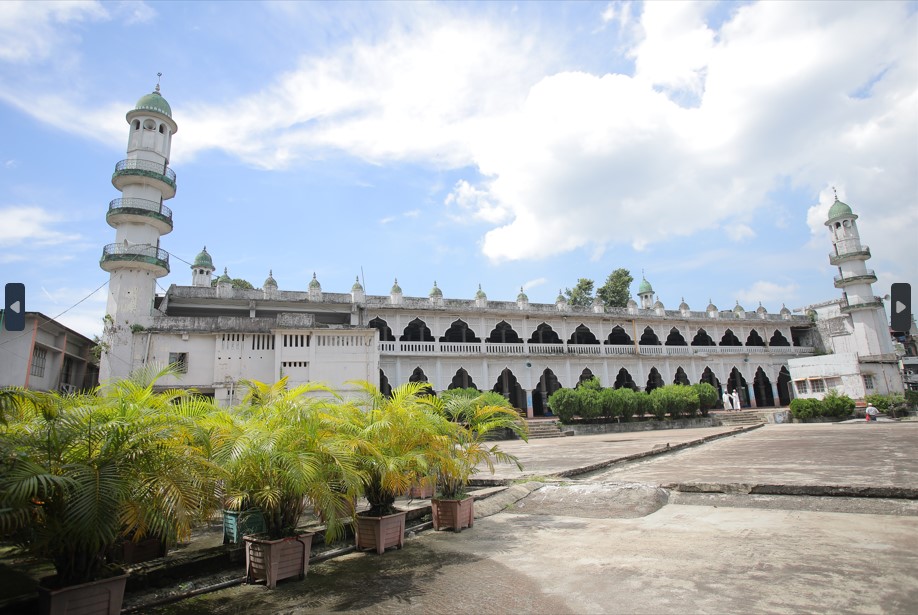
Anderkilla Jame Mosque, Chottogram

Camera from Extension

South Door

Inner Shilalipi

Mihrab

Inner Arch Top

Three Gumbad on Top
Introduction
The Anderkilla Shahi Jame Mosque, located in the heart of Chittagong, Bangladesh, stands as a testament to the rich cultural and architectural heritage of the Mughal era. The Mosque was established in the 17th century and remains a significant religious and cultural landmark in the region. Its establishment during the Mughal period highlights the architectural prowess of that era and reflects the socio-cultural dynamics and the spread of Islam in Bengal.
Historical Background
The Mughal Empire, renowned for its architectural marvels, left an indelible mark on the Indian subcontinent. Chittagong, an important port city, was no exception. The Anderkilla Shahi Jame Mosque was built under the Mughal rulers’ patronage, specifically during Emperor Aurangzeb’s reign in 1667. The mosque was constructed under the supervision of Nawab Shaista Khan, the Mughal governor of Bengal, who was instrumental in consolidating Mughal authority in the region.
Architectural Significance
The Anderkilla Mosque is an exquisite example of Mughal architecture, characterized by its grandeur and intricate designs. The mosque features a blend of Persian and indigenous Bengali architectural elements, which is a hallmark of Mughal constructions.
Exterior Design
The mosque’s exterior is adorned with intricate floral and geometric patterns, a typical feature of Mughal architecture. The main entrance is flanked by two tall minarets, which were not only functional for the call to prayer but also added to the mosque’s aesthetic appeal. The façade of the mosque is decorated with terracotta tiles, which have retained their beauty over the centuries.
Interior Layout
The interior of the Anderkilla Mosque is equally impressive. The prayer hall is spacious, with a high vaulted ceiling supported by numerous arches. The mihrab (prayer niche) and the mimbar (pulpit) are elaborately decorated with calligraphy and floral motifs, showcasing the artistry of the craftsmen of that era. The mosque’s floor is traditionally covered with prayer rugs, creating a serene and spiritual ambiance.
Religious and Cultural Importance
The Anderkilla Shahi Jame Mosque holds immense religious significance for the Muslim community in Chittagong. It has been a center for Islamic learning and religious activities since its inception. The mosque is especially crowded during the Friday congregational prayers and the Islamic holy months of Ramadan and Muharram.
Beyond its religious role, the mosque has also been a cultural hub. It has witnessed numerous historical events and has been a site for community gatherings and social functions. The mosque’s role in the cultural life of Chittagong highlights the intertwined nature of religion and culture in the region.
Preservation and Renovation Efforts
Over the centuries, the Anderkilla Mosque has undergone several renovations to preserve its structural integrity and aesthetic beauty. The most significant renovation efforts were undertaken in the early 20th century, ensuring that the mosque remained a functional place of worship while retaining its historical charm.
Recent efforts by the government and local authorities have focused on maintaining the mosque’s architectural heritage. These efforts include restoring the original terracotta designs, reinforcing the structural framework, and ensuring that any new additions are in harmony with the mosque’s historical design.
Challenges and Future Prospects
Preserving a historic structure like the Anderkilla Shahi Jame Mosque presents several challenges. The humid climate of Chittagong, coupled with urbanization pressures, poses a threat to the mosque’s structural integrity. Additionally, balancing the needs of a modern congregation with the preservation of historical elements requires careful planning and execution.
However, with increasing awareness about cultural heritage and the importance of historical preservation, there is hope for the future. Initiatives to document and study the mosque’s history and architecture are gaining momentum. These efforts not only help in preserving the mosque but also in educating future generations about their rich cultural heritage.
Conclusion
The Anderkilla Shahi Jame Mosque of Chittagong is more than just a place of worship; it is a symbol of the city’s historical and cultural legacy. Established during the Mughal era, the mosque stands as a testament to the architectural brilliance and cultural richness of that period. Its intricate designs, historical significance, and enduring role in the community make it a cherished landmark in Chittagong.
As we move forward, it is imperative to continue efforts to preserve this historical gem. By doing so, we honor not only the architectural achievements of our ancestors but also the cultural and religious traditions that have shaped them.